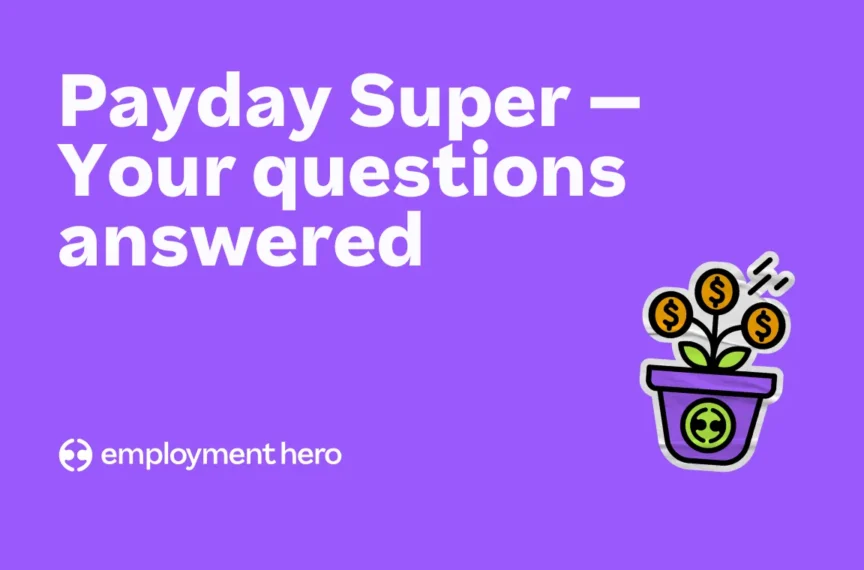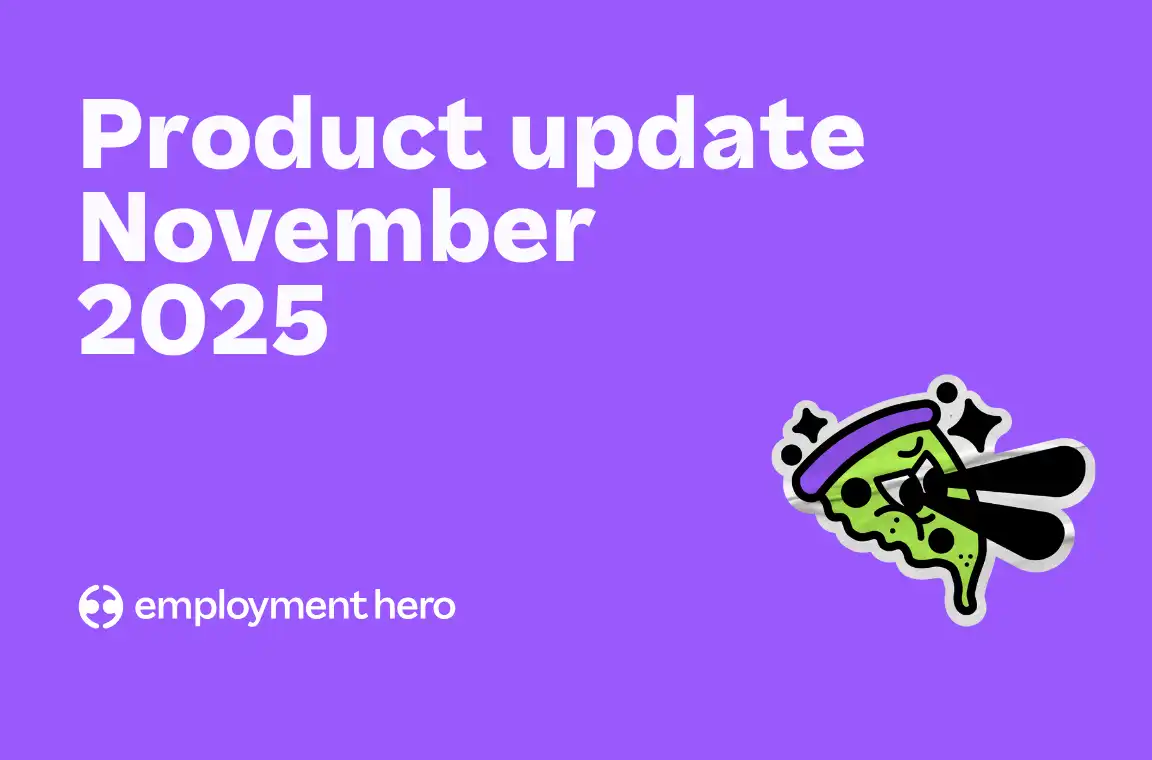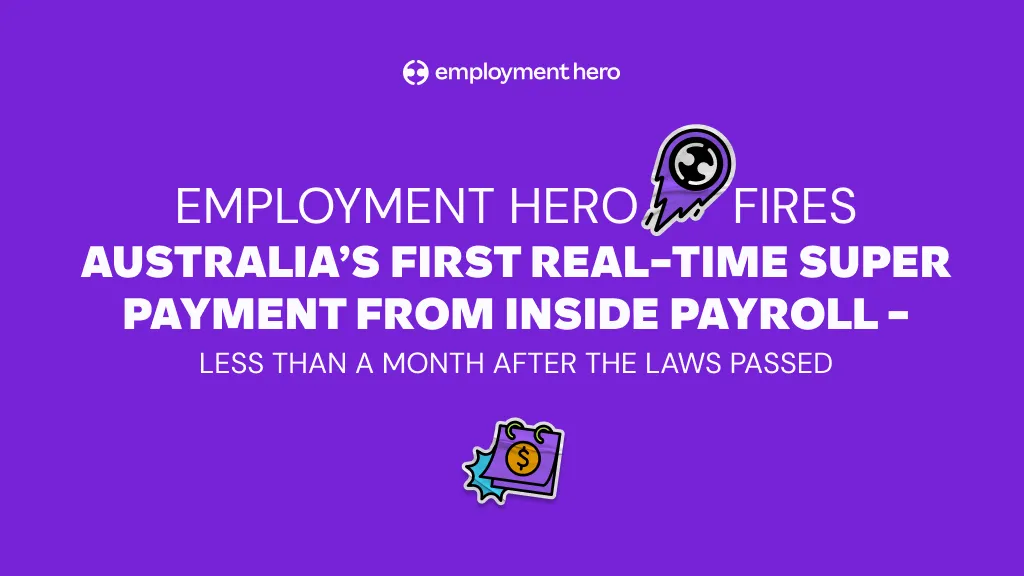
Contents
Payday Super – Your questions answered
Ahead of seeing final legislation, our experts have gone through some of the top questions employers asked during our Payday Super webinar, to give businesses some further confidence leading up to the 1 July deadline.
Employment Hero superannuation experts, Robb Dunn and Tanya Dreup recently hosted a webinar on what employers need to know about Payday Super. It was clear that businesses need more information and greater clarity on what Payday Super means for them.
Ahead of seeing final legislation, our experts have gone through some of the top questions you asked in the webinar, to give employers some further confidence leading up to the 1 July deadline.
The basics
From 1 July 2026, employers must pay Superannuation Guarantee (SG) contributions on payday, rather than quarterly. Super must be received by employees’ super funds within seven calendar days of each payday.
The reform is designed to reduce unpaid super (estimated at ~$5.2 billion annually), improve retirement outcomes and help employees see super contributions in real-time.
Payment timing & deadlines
Under the current legislation, contributions must be received by the fund within seven calendar days of each payday. This includes weekends and public holidays, so paying on or before payday is recommended.
If it’s an “out-of-cycle” payment (bonus, back pay), super can be paid with the next regular pay run instead of immediately.
You can keep your pay frequency but super for that cycle must still reach the fund within seven days of payday.
You can start making more frequent super contribution payments as soon as you are ready. Employment Hero already has customers who are completing super contribution payments as part of their standard payroll cycle.
Clearing houses & processing
Yes, Employment Hero will continue to support the Beam integration and ability to export SuperStream alternative file format (SAFF) extracts for other clearing solutions. Clearing houses are updating their processes in response to Payday Super.
The current legislation states Employers remain responsible. We suggest employers submit payments on payday (or earlier) and keep proof of lodgement.
We are still early building this solution so cannot confirm yet if it will support payments from multiple bank accounts. However, this is very valuable feedback that we will account for in development.
Errors, bounced payments & fund mergers
It is the employer’s responsibility to re-submit to the correct fund as soon as you have the new details. It is best to keep records; the ATO has limited discretion where the delay is beyond your control.
Yes. Funds must notify employers and the ATO at least 2–4 weeks in advance. There will be improved notifications in the event of fund closure or merger.
Cash flow & business impact
This is something you need to model and consider but there is a high risk that more frequent payments mean less flexibility to hold super accruals for quarterly submission. Employers will need to manage cash reserves more carefully.
The current draft legislation does not include any concessions. The new rules apply to all employers, regardless of size. However, Employment Hero has been advocating with the government for a phased roll out, to better support small businesses through the transition.
To date, we have not heard any consideration for cashflow assistance measures for business during the transition period.
Compliance & penalties
We have not received exact details of how this will happen and understand this remains under consideration. However, the ATO does have the ability to match STP payroll data (when wages are paid) with fund data (when super is received) via SuperStream. If there’s a mismatch, employers may face the Superannuation Guarantee (SG) charge.
If contributions aren’t received within seven days of payday, employers incur an SG shortfall, plus interest and penalties (up to 60% of the shortfall).
The ATO does. They will raise the SG charge if payments are late or missing, based on STP and fund data. It is not handled through your clearing house.
Employers must lodge a Superannuation Guarantee (SG) statement with the ATO when super is missed or underpaid. The ATO provides an online SG statement form through the Business Portal/Online Services for Business.
Special cases
This would primarily depend on the contractual agreement. If a contractor is deemed an “employee” for SG purposes (paid mainly for their labour), Payday Super rules apply. Super is due within seven days of the payday (when you pay them), not the invoice date. We recommend employers carefully review contractor agreements and seek legal advice as required.
You must request their choice. If not provided, the ATO will supply their stapled fund. Employers cannot delay payments waiting for employee information and should revert to the employees’ stapled fund or the employer default fund as needed. Also, for new employees, employers have 21 days to submit the super contribution after the first QE day. If the next QE day is within 14 days, it is still due within 21 days of the first QE day.
Yes. The Payday Super rules apply to all employers, including charities and NFPs.
End of ATO’s Small Business Super Clearing House (SBSCH)
The Small Business Super Clearing House will close to new users from October 2025 and shut down completely by June 2026. Businesses must switch to an alternative clearing solution.
Tax deductibility & EOFY timing
The fund must receive the payment by 30 June. Pay early, check provider cut-off dates and use faster payment options like NPP to avoid missing deadlines.
Contribution caps & overpayments
There is a risk, as in some cases the timing may result in 13 contributions in a year. The Treasury was provided this feedback during industry commentary on the draft legislation. If this event were to transpire, we recommend employers flag this with affected employees as early as possible.
Super contributions generally cannot be refunded to the employer once allocated. Overpayments stay in the employee’s account. This is why it is important to use an integrated payroll system to help with the accurate calculation and payment of super contributions.
Disclaimer: The information in this article is current as of 30th September 2025, and has been prepared by Employment Hero Pty Ltd (ABN 11 160 047 709) and its related bodies corporate (Employment Hero). The views expressed in this article are general information only, are provided in good faith to assist employers and their employees, and should not be relied on as professional advice. The Information is based on data supplied by third parties. While such data is believed to be accurate, it has not been independently verified and no warranties are given that it is complete, accurate, up to date or fit for the purpose for which it is required. Employment Hero does not accept responsibility for any inaccuracy in such data and is not liable for any loss or damages arising either directly or indirectly as a result of reliance on, use of or inability to use any information provided in this article. You should undertake your own research and to seek professional advice before making any decisions or relying on the information in this article.
Related Resources
-
 Read more: PEO vs. EOR: A guide to global hiring
Read more: PEO vs. EOR: A guide to global hiringPEO vs. EOR: A guide to global hiring
Learn the key differences between a PEO and an EOR. Discover why an EOR is the smarter, safer way to…
-
 Read more: Product Update: November 2025
Read more: Product Update: November 2025Product Update: November 2025
Welcome to the November 2025 product update from the Employment Hero team. We’ve got lots to share around Workflows, Rostering,…
-
 Read more: Payday Super pressure eased: Employment Hero fires Australia’s first real-time super payment from inside payroll – less than a month after the laws passed
Read more: Payday Super pressure eased: Employment Hero fires Australia’s first real-time super payment from inside payroll – less than a month after the laws passedPayday Super pressure eased: Employment Hero fires Australia’s first real-time super payment from inside payroll – less than a month after the laws passed
One month on, Employment Hero, Zepto and OZEDI deliver the first payroll-embedded super-clearing payment over the New Payments Platform (NPP),…























